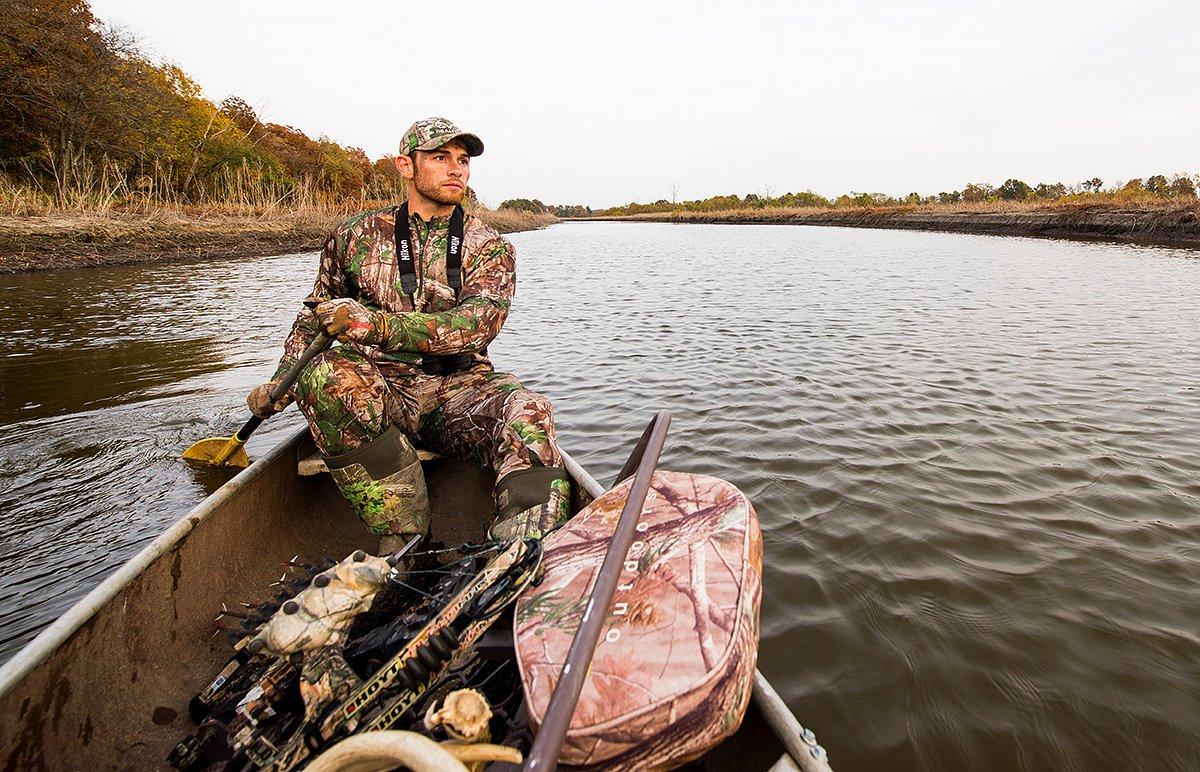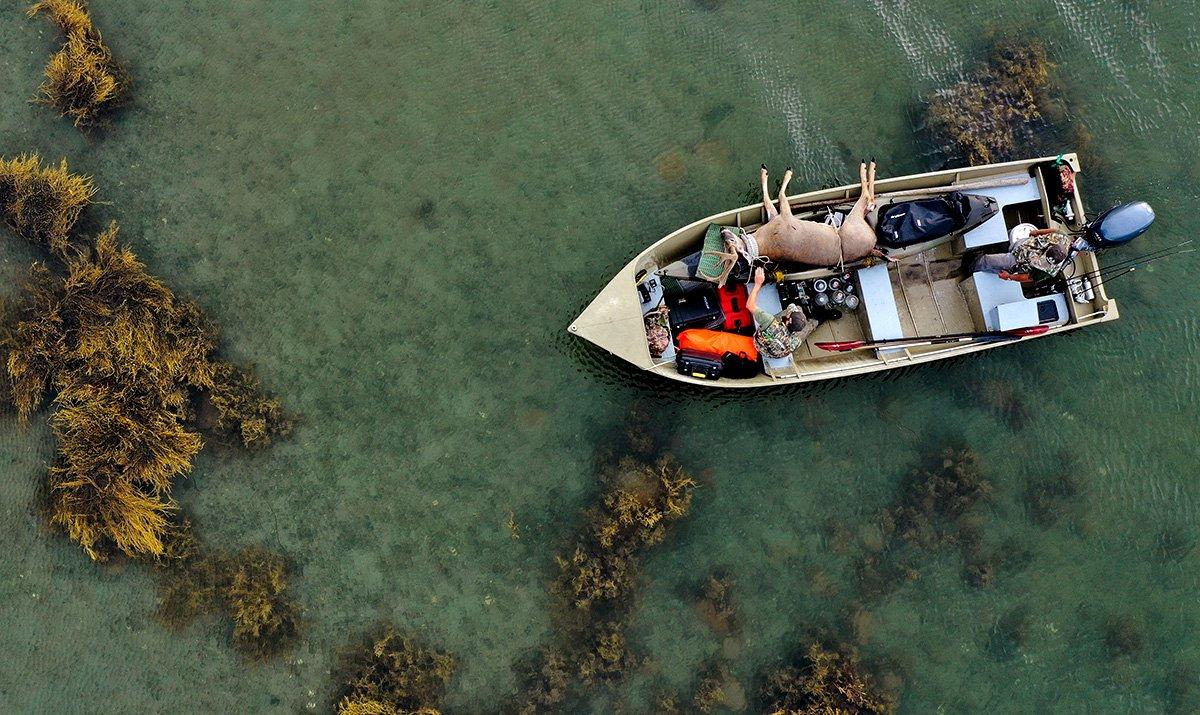Sneaking in by water can open a whole new world of deer hunting access and opportunity
It's the eve of opening day of Maine's 2019 expanded archery season, and John Altman is listening to news he'd rather not hear. A NOAA weather radio reports wind speeds of 20 knots and 13-foot swells. Altman and his hunting crew specialize in hunting coastal islands in the expanded archery zones, and one island buck in particular would be the pinnacle prize — a 12-year-old heavyweight nicknamed Bigfoot.
But with this forecast, there'll be no hunting. At least, not for a couple of days, until the weather settles down. The seas are simply too hostile right now for reaching the islands in an 18-foot Lund. The hunters instead wait: sharpening broadheads, talking strategy, and biding their time.
Finally, after three days, fairer winds blow, and the crew loads the boat with dry bags full of supplies. They check the tides and depart for the island, miles from the mainland.
Despite having hunted Bigfoot for five seasons, Altman has never actually laid eyes on the deer. But he's learned a lot about him, and so he slips in on the first afternoon for a hang-and-hunt set over an apple tree heavy with fruit. It's an area where they'd purposely avoided hanging trail cameras over the summer. The play pays off, and seeing the buck in broad daylight is impressive, to say the least. You have to watch the hunt to appreciate it.
And after you do, chances are you'll be at least curious about using a boat to bag your next buck.
—W.B.
The Benefits of Water Access
Water access can provide all sorts of advantages for deer hunters. Sneaking in by boat can create a perfect entry and exit route. It can even open up additional public hunting opportunities in the form of islands, public shorelines, and otherwise landlocked tracts.
When it comes to freshwater access via lakes, rivers, and streams, The Hunting Public (THP) crew has it figured out. More times than not, water yields the lowest-impact entry and exit, says THP's Aaron Warbritton. Water access decreases ground scent. This allows you to hunt an area more frequently.
Many private and public lands are bordered or split by rivers, but there's more to hunting them than just throwing a stand in the boat and going. Sandbars, flooding, tall cutbanks, and other environmental factors can change how accessible these areas will be at any time. You can monitor the flow and levels of many larger rivers and lakes online, but it takes time on the water to learn what conditions are ideal for the spot you're planning to hunt.
With the right plan, Warbritton says you can use the water to your advantage, because certain features are especially attractive to whitetails. On rivers, he explains, look for oxbows, or even just sharp bends in the river, next to easy crossings. Deer like to bed on those points, with the wind coming in from the land side. If they detect a predator, they can quickly escape, through the crossing, to put water between themselves and the predator.
On lakes, the heads of coves, which are low-lying and offer plenty of escape options, are choice areas. Deer won't usually bed on a point of land way out in the middle of a lake, but they do frequent the heads of coves, Warbritton says.
Don't Sound the Alarm
Noise carries on the water. Many boaters give themselves away long before they ever start hunting. Don't motor all the way to your spot with an outboard. Enter stealth mode at least 300 yards out. Use a really quiet trolling motor for the final approach, Warbritton says. Even in a canoe or kayak, you still have to avoid splashing in the water.
Don't beach boats in coves or near other hunting spots, either. Instead, park around the downwind corner and hoof it the rest of the way.
As for watercraft gear and setup specifics, Warbritton has his preferences. Our boat has a 25-horsepower outboard and a small trolling motor. That's the boat we use on lakes and medium-sized rivers. We keep a couple totes in it. One for all the necessary boating items (lights, life jackets, oil, etc.) and one for our hunting gear. We also bring a rechargeable spotlight along for navigating in the dark.
In addition to that, they commonly use canoes and kayaks. He recommends at least a 10-footer with tiedown options in the front and rear for gear.
Big-Water Access and Safety
From Maine to Massachusetts, there are coastal islands that support huntable deer populations. John Altman has been hunting them for decades, accessing places that other hunters aren't willing to try. Because of that, Altman routinely finds himself in remote places with mature deer. Plus, hunting the islands can provide extra opportunity. Expanded archery zones allow for more tags and gives us another month to hunt (September), he says.
In 50-degree water, the Coast Guard gives you a 50/50 chance (of survival) at 100 yards from shore.
But the Atlantic definitely puts big water into perspective. It's vital to be wary of weather and tides. In Maine, for example, there can be a 10- to 12-foot difference in the shoreline between low and high tides. And sometimes, the sea just gets too rough to chance a run. We might get stuck out there extra days because the winds and swells kick up and we don't feel comfortable coming home, Altman says. Be prepared for that. Have more provisions than you think you need. Even when scouting, never go out without provisions and a dry bag.
As backup to his usual boat, Altman and his crew bring kayaks for shallow-water access. As seaworthy as our boats are, if you swamp them, you aren't going to fare very well, he says. We haul along sit-on-top kayaks. It's an entirely closed system. Water can't get inside unless you bust a hole in it. If we really get into trouble, we at least have something that floats. He always carries both a cellphone with extra charging banks and a marine radio, plus a primary and secondary GPS. And like Warbritton, Altman stresses the importance of life jackets, even in shallow water. Going overboard can be a death sentence. In 50-degree water, the Coast Guard gives you a 50/50 chance (of survival) at 100 yards from shore, Altman says. That's not very far.
Once near the target island, Altman usually prefers to anchor the boat and use the kayaks to approach his final destination. This allows for quieter entry and exit, catching deer off guard. Many of these island whitetails hug the coastline, and they know a motor when they hear one.
Done correctly, the time and energy spent can lead to a great payoff. In the past 20 years, Altman has bagged five mature offshore bucks, and plenty of does, too. But more than antlers or full freezers, this is an experience that's about as far removed as you can get from a sit over a Midwestern cornfield or food plot.
That in itself is cool. What more reason do you need to try a boat for your next buck?










